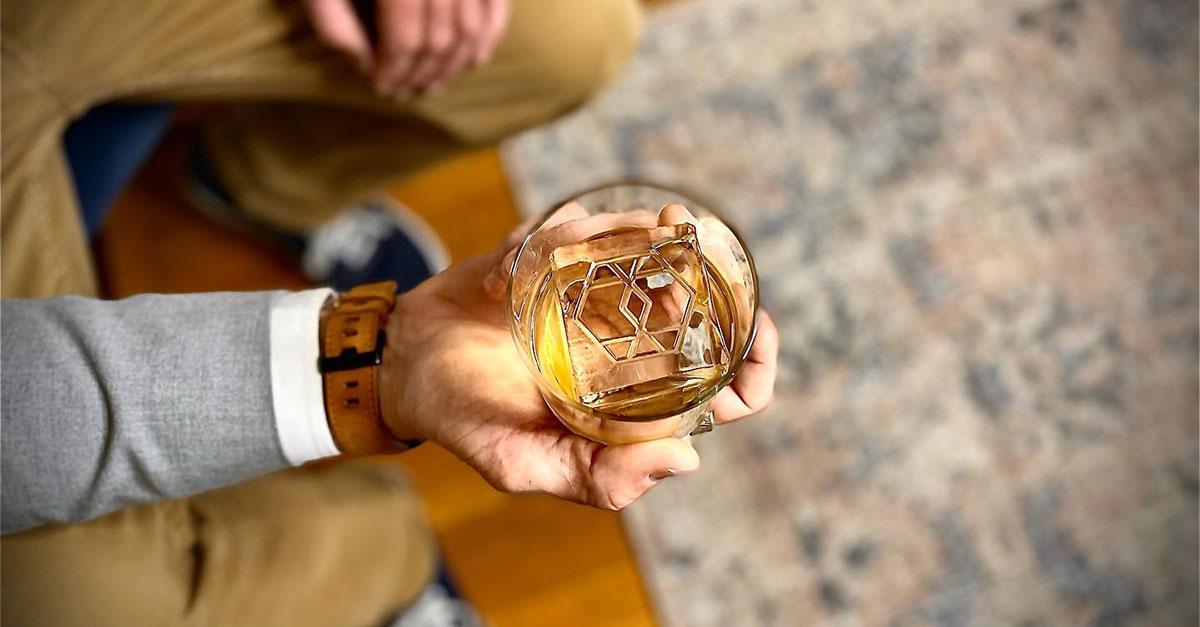Some people just want to know how stuff works. So if you’re the curious type and the ice in your cocktail has you wondering how ice is made in the first place—or why the ice served in your bar cocktail seems to look and taste so much better than the ice at home—then you’re in the right place.
We’re breaking down the science behind how ice is made and how to make clear ice.
Ready to return to science class? Pour yourself a cocktail and let’s go!
How Ice Is Made
Yes, you already know that ice happens when water freezes. But the science behind how ice is made is actually a bit more interesting than that.
H2O molecules are always moving. As temperatures rise, these water molecules move faster. And as water molecules cool, they slow down.
Water boils at temperatures around 212°F when the heated water molecules start moving so quickly and frantically that they vaporize and turn into a gas.
On the other hand, cold temperatures will slow water molecules way, way down. They slow down so much that, once they hit 32°F, they hook onto one another, forming a solid crystal.
Voila! Ice is made.
Fun fact: Do you know why ice cubes float? As water transforms into ice, it expands and becomes less dense— about 9% less dense— than its original liquid state. The heavier water displaces the lighter ice, and the ice cubes float up to the surface of your glass.
What Makes Ice Clear (Or Cloudy)?
Three factors determine if an ice cube is cloudy or clear:
- Impurities
- Directional freezing
- Rapidness
Impurities
Looking at a cloudy freezer cube, you may think to yourself: “yuck.”
It’s easy to imagine that cloudy mass as one big ball of grossness, full of weird freezer flavors, odors, and even nasty contaminants.
But the reality is, most of the “impurities” found in your freezer ice cube are more likely nothing more than the minerals present in your tap water.
Tap water commonly contains minerals such as:
- Calcium
- Magnesium
- Potassium
When water freezes and ice crystals form, there is no room in the resulting crystal for any impurities (minerals, dissolved gasses, and other contaminants) or air. The ice crystal “pushes” the impurities and air out of the way.
When you fill an ice mold and set it in your freezer, the water begins freezing from the outside in. This pushes any minerals, impurities, or air bubbles toward the center, resulting in ice that’s cloudy in the middle.
Did you know? During the freezing process, the ice basically purifies itself. Even salt can be pushed out of salt water as it freezes. According to the National Ocean Service, frozen seawater can be melted down to use safely as drinking water.
Directional Freezing
Another reason your ice cubes get cloudy at home is directional freezing.
Think of a lake that freezes over in the winter. As the cold air freezes above the lake, the water at the top of the lake begins to freeze. The colder it gets up top, the further down the lake will freeze.
But a lake rarely freezes over entirely, and even though the top layers are frozen, you’ll still find fish swimming around in unfrozen water near the bottom.
That means the top frozen layers have purified themselves, pushing any impurities, air bubbles, and minerals down toward the bottom.
Unlike a lake that’s freezing in one direction, the ice cubes at home in your freezer are chilling at equal rates from all sides. As they freeze uniformly from all directions, the impurities are pushed and trapped into the middle of the cube.
Rapidness
Minerals and other impurities aren’t the only things trapped in your cloudy ice cubes. When your water cools rapidly, tiny air bubbles form and get trapped within the crystalline ice structure. These tiny cracks also get pushed in towards the center of the ice cube.
If the water cools rapidly, these tiny cracks and air bubbles will be visible and will make your ice appear cloudy.
If your ice cools slowly, however, you won’t get the same visible spider web of cracks in your cubes.
So, now that you know how ice is made and what makes ice cloudy let’s find out how commercial clear ice is made.
How Do You Make Clear Ice?
Cloudy ice is the result of water contaminants, rapid cooling, and freezing that occurs from all directions. So clear ice can be made if you can remove impurities from the water, cool your cubes slowly, and freeze your water from one direction only (directional freezing).
If you ever were wondering how to whip up some clear ice at home, there are plenty of relatively easy and inexpensive ways to do so. Check out our full guide here and impress all your guests at your next get-together.
But for making large amounts of clear ice for commercial (or even home bartending) purposes, it’s a lot of work, and a lot of mess, to repeatedly attempt.
That’s why commercial clear ice for use in bars and restaurants typically comes from a specialty machine built for this purpose.
How Is Commercial Clear Ice Made?
At Block Ice, we use a commercial piece of equipment that slowly freezes water from the bottom up. The water is 7x filtered using a reverse osmosis process to remove as many impurities as possible and then circulated at the top using a pump. Purified water, slow freezing time, and directional freezing: check, check, check.
The result?
HUGE blocks of completely clear ice.
Once these giant blocks of crystal clear ice are formed, they are carved down into cubes that fit inside your favorite cocktail glass. (And we’re not using serrated kitchen knives either: these giant blocks of ice require some serious power equipment!)
Our cubes can be personalized with stamps featuring a bar or restaurant logo or even infused with edible flowers, edible gold flakes, and other personalized touches for a wedding or other special event.
How Do Bartenders Make Clear Ice?
Want to know an industry secret? Your bartender isn’t making clear ice behind the bar of your favorite restaurant, nightclub, or speakeasy.
Now that you know what’s involved in creating a perfectly clear ice cube, you can understand how your favorite bartender wouldn’t have the time to go through all of the required steps to DIY a clear ice cube.
And most bars, hotels, and restaurants don’t have the room to house a commercial-sized ice maker, or the power tools required to turn a six-foot-long block of ice into glass-sized cubes.
Which is why most bars and restaurants order their clear ice cubes from commercial ice vendors like Block Ice.
Where To Find Clear Ice For Your Home Bar
You don’t have to be a commercial establishment to have clear ice for your home bar. And you definitely don’t need to turn your kitchen into a mess doing DIY experiments, either.
You can get the exact same Block Ice cubes used by your favorite Northern CA restaurants and bars by grabbing a bag of clear ice from a Sacramento-area Nugget Market near you.
There’s your dose of science for the day. If you read this far, pour yourself another cocktail and celebrate.
And don’t forget the ice!
The Best Drinks to Serve with Clear Ice
Whiskey on the Rocks
As a cocktail with literal ice in the name, this is one of the best cocktails to put your new clear ice to the test and see the true beauty of craft ice.
Old Fashioned
If you want a step up from just chilled neat whiskey, the Old Fashioned is your next best option to enjoy the benefits of your ice blocks.
Negroni
Combining the best of gin, vermouth, and Campari, this red drink is one of the best to highlight the clarity of your crafted cubes.
Boulevardier
Combining both the negroni and the old-fashioned, the Boulevardier features vermouth and Campari but replaces the gin with whiskey, making a sunset red hue.
If you’re looking for even more cocktail ideas to be enjoyed on the rocks, check out our full list of our favorite drinks meant to be paired with craft ice.
This blog was updated in February 2024 to include even more in-depth info on clear ice & how you can use it. It was originally published in 2023.

